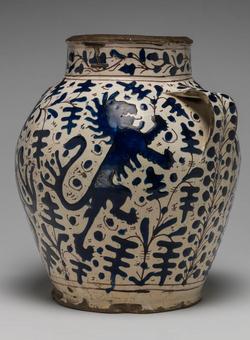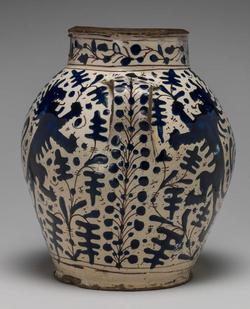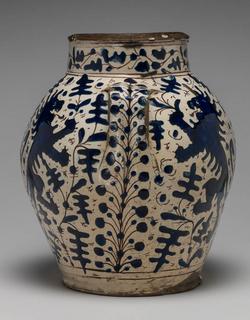Current Location: Gallery 7 (Courtauld)
Maker(s)
Maker:
Unidentified Florence pottery
(District of)
Entities
Categories
Description
Maiolica pharmacy or storage jar, painted in relief-blue, on both sides with two lions rampant addorsed and 'oak leaves'.
Buff earthenware, tin-glazed creamy-white on the interior and exterior; the rim and base unglazed. Painted in bright, extremely shiny relief-blue with manganese outlines.
Ovoid with flat base, short cylindrical neck and two strap handles.
Both sides are decorated with two lions rampant addorsed, each holding a spray of oak leaves in its raised paw, surrounded by sprays of oak leaves with dots in the background. Round the lower part of the body there are two horizontal manganese bands. On the neck, between pairs of horizontal manganese bands, there are oak leaves on a wavy stem. On each handle, and continuing down the side of the jar beneath it, is a fern frond or stalk with twigs branching off on each side and terminating in small round berries.
Notes
History note: Sir Otto Beit; Sir Alfred Beit; Sotheby's, 16 October 1942, Catalogue of important Italian majolica, the property of Sir Alfred Beit Bt, MP., lot 15; C. H. St J. & Cicely Hornby; Louis C.G. Clarke.
Legal notes
L.C.G. Clarke Bequest, 1960
Measurements and weight
Height: 25.8 cm
Acquisition and important dates
Method of acquisition: Bequeathed
(1961-04-27)
by
Clarke, Louis Colville Gray
Dating
15th Century
Renaissance
Circa
1420
CE
-
1450
CE
Note
Lions were not unfamiliar to Florentines during the late Middle Ages. The chronicler, Giovanni Villani, mentions them on several occasions, including cubs born in Florence and given away as diplomatic gifts. Their occurrence on `oak leaf jars', either singly or in addorsed pairs, was probably due to their popularity as heraldic devices in Florence and elsewhere in Tuscany, or to the use of a lion, known as the marzocco, as an emblem of the city.
School or Style
Renaissance
Components of the work
Decoration
composed of
high-temperature colours
( shiny relief-blue with manganese outlines)
Mouth
Diameter 12.4 cm
Base
Diameter 14.5 cm
Across Handles
Width 23 cm
Body
Materials used in production
except rim and base
Tin-glaze
Earthenware
Techniques used in production
Tin-glazing
Inscription or legends present
Inscription present: circular label
- Text: 'ST. JOHN AND CICELY HORNBY' printed round the edge in green, 'No' in the centre, and, 'D.200' inscribed below in faded blue-black ink
- Method of creation: Printed in green and inscribed in blue-black ink
- Type: Label
- Text: 740
- Method of creation: In red paint and again in black ink
- Type: Mark
References and bibliographic entries
Related exhibitions
Identification numbers
Accession number: C.77-1961
Primary reference Number: 48175
Stable URI
Audit data
Created: Saturday 6 August 2011
Updated: Tuesday 30 April 2024
Last processed: Wednesday 14 May 2025
Associated departments & institutions
Owner or interested party:
The Fitzwilliam Museum
Associated department:
Applied Arts

 IIIF Manifest
IIIF Manifest








